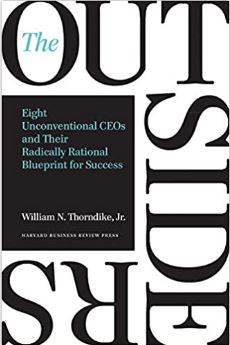
The Outsiders
The Outsiders is a book about 8 idiosyncratic CEOs who were able to generate an astounding average return for their shareholders by outperforming the S&P 500 by over 20 times and the peer group by over 7 times, primarily by focusing on capital allocation and decentralising operations. In the Outsiders, William dwells on the traits and methods applied by these unique leaders to achieve such exceptional performance, and the lesson those decisions hold for today’s managers and entrepreneurs. William’s research on these 8 CEOs and his ability to extract the key ingredients which led to their success, is exceptional.
All of these CEOs were outsiders as all were first-time chief executives (half not yet forty when they took the job), and all but one were new to their industries. They were not bound by prior experience or industry convention, and their collective records show the enormous power of fresh eyes. This fox-like outsider’s perspective helped these executives develop differentiated approaches, and this informed their entire management philosophy. As a group, they were deeply independent, generally avoiding communication with Wall Street, disdaining the use of advisers, and preferring decentralised organizational structures. Below are some of the snippets from the book, which I found most striking;
Tom Murphy CEO of Capital Cities had a highly differentiated capital allocation approach from his peers. He rejects diversification and instead created an unusually streamlined conglomerate that focused laser-like on the media businesses it knew well. He paid de minimis dividends, rarely issued stock, made active use of leverage, regularly repurchased shares, and between long periods of inactivity made the occasional very large acquisition.
Henry Singleton CEO was founder of Teledyne which was an industrial conglomerate that had acquired 130 companies, ranging from aviation electronics to specialty metals and insurance. It focused on profitable, growing companies with leading market positions, often in niche markets mainly using Teledyne’s pricey stock as the acquisition currency. However, with the multiple on his stock falling and acquisition prices rising, he bought back an astonishing 90 per cent. of Teledyne’s outstanding shares at low P/Es whilst revenues and net income continued to grow, resulting in an astonishing fortyfold increase in earnings per share.
Bill Anders, CEO of General Dynamics, turnaround strategy was highly unusual. Following the crash of defence stocks he sold the majority of General Dynamics’s businesses but chose to remain in those businesses which were numbers one or two by market leadership. Instead of investing the cash, Anders chose to return most of it to shareholders through innovative tax-efficient techniques.
John Malone was the CEO of TCI which became the largest cable company. He achieved this through investments in joint ventures in order to increase scale and value for shareholders. At the time of the sale to AT&T, the company had forty-one separate partnership interests. It had the lowest programming costs the least maintained facilities, most complex structure, and, oh yes, far and away the highest returns.
Katharine Graham CEO of The Washington Post’s defining managerial trait was her unique ability to identify and attract talent to both the company and the board. The decision to welcome Warren Buffett (who had accumulated a large chunk of Post’s stock) onto the Company’s board was a highly independent and unusual since Buffett was virtually unknown. Again, the choice of a mentor is a critically important decision for any executive, and Graham chose unconventionally and extraordinarily well.
Warren Buffett CEO of Berkshire Hathaway bought his first share of Berkshire Hathaway for $7. Today, the stock is worth over $400,000. Buffett’s story best exemplifies the idea of the CEO as an investor. His ability to invest not only in the best people but also business for long-term, avoiding the unnecessary financial and human costs of churn. He was an extremely efficient manager of a growing portfolio of operating businesses, and through extreme decentralisation has been the cornerstone of exceptional returns.
All the outsider CEOs took the approach of a long-term investor, rather than a highly paid employee. As stated in the Preface to the book all eight CEOs believed, amongst other things that:
• Capital allocation is a CEO’s most important job.
• What counts in the long run is the increase in per share value, not overall growth or size.
• Cash flow, not reported earnings, is what determines long-term value.
• Decentralised organisations release entrepreneurial energy and keep both costs and ‘rancour’ down.
• Independent thinking is essential to long-term success, and interactions with outside advisers can be distracting and time-consuming.
• Sometimes the best investment opportunity is your own stock.
• With acquisitions, patience is a virtue … as is occasional boldness.
William sums up the book with an extremely helpful outsider checklist derived from his learnings of these 8 Outsider CEOs. This is a tool which can help any business steer through challenging times and generate exceptional returns for their shareholders. As an analyst, the book has added immense value to me and will help me to identify the right CEOs to invest over the long term.
Shahil Shah
7 September 2022
